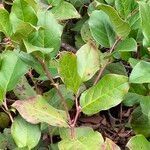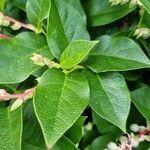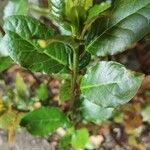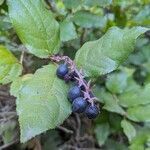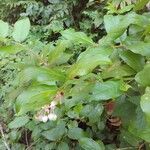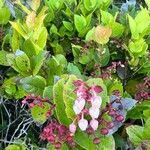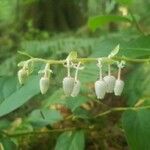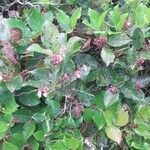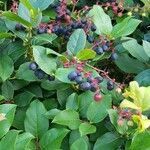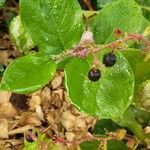Shrubs, creeping, not mat-forming, rhizomatous. Stems erect to partially erect, (greenish), 50-200+ cm, ± glandular-hairy, glabrescent. Leaf blades oval to ovate or orbiculate to reniform, 4-8+ cm, base rounded or cordate, margins serrulate (teeth fimbriate apically), apex mucronate/apiculate or aristate, surfaces glabrous. Inflorescences axillary, drooping, secund racemes; peduncle deep pink to red, 7-15+ cm, densely glandular-hairy; bracts white to light pink, deltate, 4-6 mm, not exceeding sepals, glandular-hairy marginally. Pedicels white, 7-10 mm, densely glandular-hairy; bracteoles 1-5, pinkish white, parallel-veined, oblanceolate, 3-5 mm, densely glandular-hairy. Flowers: sepals 5, distinct nearly to base, dark pink to red, narrowly deltate, 3.5-5 mm, glandular-hairy (hairs reddish); petals 5, connate nearly their entire lengths, white to light pink, 7-8 mm, densely glandular-hairy, corolla narrowly urceolate, lobes 1 mm; filaments widest proximally, glabrous, papillose; anthers with 2 apical, bifurcating awns, dehiscent by subterminal pores proximal to awns. Fruits black-purple, 6-8 mm wide. 2n = 22, 44.
More
Shrub to c. 50 cm tall, usually forming a dense low thicket with underground rhizomes and numerous aerial ascending stems. Shoots hirsute and glandular when young. Lvs alternate; petioles 2-5 mm long. Lamina 4-7 × 3-4.5 cm, ovate to suborbicular, with glandular hairs when young, glabrous and coriaceous when mature, serrulate with glandular teeth; base subcordate to cordate; apex mucronate or shortly cuspidate. Racemes subterminal, to c. 10 cm long, reddish, ± viscid with glandular hairs. Bracts mostly 7-10 mm long, ovate, mucronate, reddish, > pedicels. Calyx c. 3 mm long; lobes triangular-ovate, reddish. Corolla c. 8 mm long, urceolate, with glandular hairs outside, whitish or pale pink; lobes small and revolute. Filaments hairy; anthers with 4 apical awns c. 1.5 mm long. Style = or slightly > corolla tube. Frs purplish black and berry-like but not seen in N.Z. specimens.
A suckering shrub. It grows to 1.2-3 m high. It spreads by underground suckers. The branches also take root along the ground. The leaves are broadly oval and 10 cm long. The flowers occur in loose flower clusters. They are white or pink and at the end of branches. The fruit are fleshy and purple. They are 12 mm long. They have many small seeds. The fruit are edible.
It is a temperate plant. It is native to North America. It grows naturally in mixed evergreen forests. It suits shady spots. It is very cold hardy. It does well in moist, humus rich, peaty soil. It suits hardiness zones 5-9.
More
Grows on sandy or peaty soils in shady positions from the coast up to elevations of 800 metres. Woods and transition zones, moist soils, rocky or sandy cliffs, coastal bluffs; at elevations up to 1,300 metres.
The fruit can be eaten fresh or dried. The fruit are used in preserves, pies, jellies, jams and syrup. They can be dried and stored. They can be eaten like raisins. The fruit are used for drinks and made into wines.
